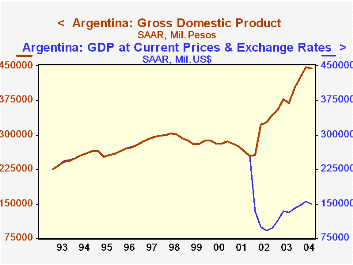 Global| Dec 17 2004
Global| Dec 17 2004Argentina Recovery Continues
Summary
Argentina's economy continues to expand, as Q3 GDP grew 2.9% (quarterly rate), a tenth consecutive quarter of growth after the 2001-2002 contraction and devaluation. In peso terms, real GDP is back now very near its prior peak; in Q3, [...]

Argentina's economy continues to expand, as Q3 GDP grew 2.9% (quarterly rate), a tenth consecutive quarter of growth after the 2001-2002 contraction and devaluation. In peso terms, real GDP is back now very near its prior peak; in Q3, it was 281.6 billion pesos, compared with a high of 291.7 billion pesos in early 1998. Both consumer spending and fixed investment have grown vigorously, as noted in the table below, although investment looks to be moderating after its initial leap when the economy turned upward in the second half of 2002.
There is still considerable inflation in Argentina, however. The implicit price deflator surged, of course, in 2002 when the peso was de-linked from the US dollar and then dropped sharply. In Q2 2002, the implicit deflator gained 25.9%; it then slowed dramatically, led by export prices, which fell 11.1% in Q1 2003. In the latest quarter, the overall deflator fell 4.0%, but the year-on-year pace has been 10.9% for the last two quarters. Rebounds in prices in the public consumption, investment and export sectors have raised total inflation. On its devaluation at the beginning of 2002, the peso jumped from 1 peso/$1 to 3.80 pesos/$1 by June. Over the following several months it settled back to just about 2.95/$1 in the middle of 2003, and it has hovered there since. The accompanying chart shows what happened to nominal GDP when the de-linking occurred.
The real growth helps the labor market, of course, with the employment rate reaching a recent high of 40.1% in Q3 (% of population), up from a low of 36.3% in early 2003. Unemployment was down to 13.2% in Q3 (% of labor force). While the employment rate is low by standards of mature industrial countries, the unemployment rate doesn't seem particularly high. Yes, it's much larger than in the US, but only a few percentage points more than France and Germany, both just under 10%. Among similar national economies, unemployment is nearly 28% in South Africa, 10.5% in Turkey and just over 11% in the cities of neighboring Brazil. So the situation in Argentina is not particularly attractive, but for all the stresses, the labor market is improving and most fundamentally, the nation's National Bureau of Statistics and Census is not shy about publishing current data.
| % Change | Q3 2004 | Q2 2004 | Year Ago | 2003 | 2002 | 2001 |
|---|---|---|---|---|---|---|
| GDP | 2.9 | 0.8 | 8.3 | 8.8 | -10.9 | -4.4 |
| Private Consumption | 2.9 | 1.0 | 8.8 | 8.2 | -14.4 | -5.7 |
| Fixed Investment | 5.8 | 2.1 | 33.1 | 38.2 | -36.4 | -15.7 |
| Implicit Price Deflator | -4.0 | 8.0 | 10.9 | 5.0 | 39.8 | -1.8 |
| Employment Rate (% of population) | 40.1 | 39.4 | 38.2 | 37.8 | 36.6 | NA |
| Unemployment Rate (% of labor force) | 13.2 | 14.8 | 16.3 | 17.3 | 22.4 | NA |
Carol Stone, CBE
AuthorMore in Author Profile »Carol Stone, CBE came to Haver Analytics in 2003 following more than 35 years as a financial market economist at major Wall Street financial institutions, most especially Merrill Lynch and Nomura Securities. She had broad experience in analysis and forecasting of flow-of-funds accounts, the federal budget and Federal Reserve operations. At Nomura Securities, among other duties, she developed various indicator forecasting tools and edited a daily global publication produced in London and New York for readers in Tokyo. At Haver Analytics, Carol was a member of the Research Department, aiding database managers with research and documentation efforts, as well as posting commentary on select economic reports. In addition, she conducted Ways-of-the-World, a blog on economic issues for an Episcopal-Church-affiliated website, The Geranium Farm. During her career, Carol served as an officer of the Money Marketeers and the Downtown Economists Club. She had a PhD from NYU's Stern School of Business. She lived in Brooklyn, New York, and had a weekend home on Long Island.





